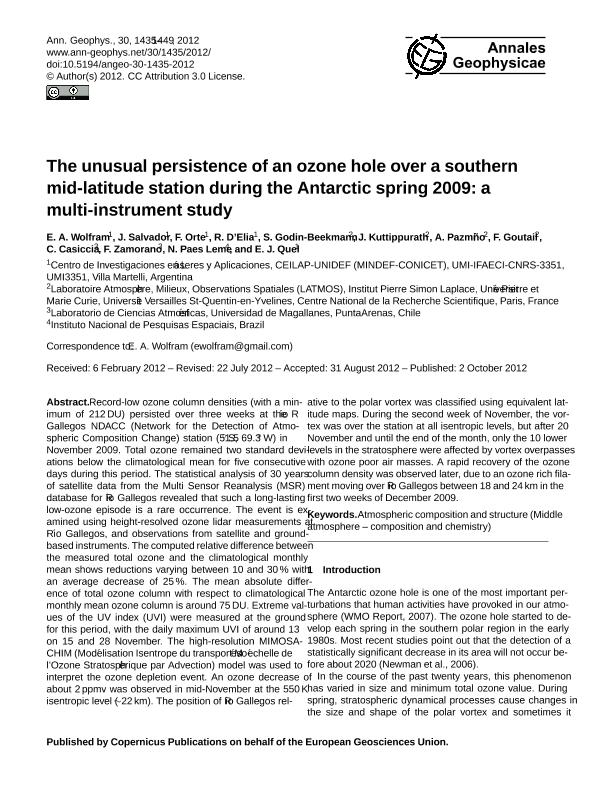Artículo
The unusual persistence of an ozone hole over a southern mid-latitude station during the Antarctic spring 2009: A multi-instrument study
Wolfram, Elian Augusto ; Salvador, Jacobo Omar
; Salvador, Jacobo Omar ; Orte, Pablo Facundo; D'elia, Raul Luis
; Orte, Pablo Facundo; D'elia, Raul Luis ; Godin Beekmann, S.; Kuttippurath, J.; Pazmiño, A.; Goutail, F.; Casiccia, C.; Zamorano, F.; Paes Leme, N.; Quel, Eduardo Jaime
; Godin Beekmann, S.; Kuttippurath, J.; Pazmiño, A.; Goutail, F.; Casiccia, C.; Zamorano, F.; Paes Leme, N.; Quel, Eduardo Jaime
 ; Salvador, Jacobo Omar
; Salvador, Jacobo Omar ; Orte, Pablo Facundo; D'elia, Raul Luis
; Orte, Pablo Facundo; D'elia, Raul Luis ; Godin Beekmann, S.; Kuttippurath, J.; Pazmiño, A.; Goutail, F.; Casiccia, C.; Zamorano, F.; Paes Leme, N.; Quel, Eduardo Jaime
; Godin Beekmann, S.; Kuttippurath, J.; Pazmiño, A.; Goutail, F.; Casiccia, C.; Zamorano, F.; Paes Leme, N.; Quel, Eduardo Jaime
Fecha de publicación:
07/2012
Editorial:
Copernicus Publications
Revista:
Annales Geophysicae
ISSN:
0992-7689
e-ISSN:
1432-0576
Idioma:
Inglés
Tipo de recurso:
Artículo publicado
Clasificación temática:
Resumen
Record-low ozone column densities (with a minimum of 212 DU) persisted over three weeks at the Río Gallegos NDACC (Network for the Detection of Atmospheric Composition Change) station (51.5° S, 69.3° W) in November 2009. Total ozone remained two standard deviations below the climatological mean for five consecutive days during this period. The statistical analysis of 30 years of satellite data from the Multi Sensor Reanalysis (MSR) database for Río Gallegos revealed that such a long-lasting low-ozone episode is a rare occurrence. The event is examined using height-resolved ozone lidar measurements at Río Gallegos, and observations from satellite and groundbased instruments. The computed relative difference between the measured total ozone and the climatological monthly mean shows reductions varying between 10 and 30% with an average decrease of 25 %. The mean absolute difference of total ozone column with respect to climatological monthly mean ozone column is around 75 DU. Extreme values of the UV index (UVI) were measured at the ground for this period, with the daily maximum UVI of around 13 on 15 and 28 November. The high-resolution MIMOSACHIM (Modélisation Isentrope du transport Méso-échelle de l'Ozone Stratosphérique par Advection) model was used to interpret the ozone depletion event. An ozone decrease of about 2 ppmv was observed in mid-November at the 550K isentropic level (~22 km). The position of Río Gallegos relative to the polar vortex was classified using equivalent latitude maps. During the second week of November, the vortex was over the station at all isentropic levels, but after 20 November and until the end of the month, only the 10 lower levels in the stratosphere were affected by vortex overpasses with ozone poor air masses. A rapid recovery of the ozone column density was observed later, due to an ozone rich filament moving over Río Gallegos between 18 and 24 km in the first two weeks of December 2009.
Archivos asociados
Licencia
Identificadores
Colecciones
Articulos(UNIDEF)
Articulos de UNIDAD DE INVESTIGACION Y DESARROLLO ESTRATEGICOS PARA LA DEFENSA
Articulos de UNIDAD DE INVESTIGACION Y DESARROLLO ESTRATEGICOS PARA LA DEFENSA
Citación
Wolfram, Elian Augusto; Salvador, Jacobo Omar; Orte, Pablo Facundo; D'elia, Raul Luis; Godin Beekmann, S.; et al.; The unusual persistence of an ozone hole over a southern mid-latitude station during the Antarctic spring 2009: A multi-instrument study; Copernicus Publications; Annales Geophysicae; 30; 10; 7-2012; 1435-1449
Compartir
Altmétricas



